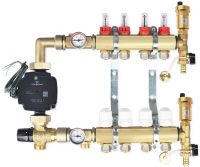Hello colleagues.
A few words about the currently operating installation: condensing gas boiler, moderately insulated house (walls 0.25-0.44W / m2K, flat insulated roof), heating based on a weather sensor and a heating curve, very oversized radiators (aluminum section and steel plate convectors ), at the current December temperatures outside, the temperature in the entire single-family building is approximately 240m2, stable around 21 ° C, and the furnace supply temperature is approximately 38 ° C.
Now in two rooms (19m2 and 22m2 new floors have been made, of course, with insulation based on EPS polystyrene, on average 10cm thick (as far as technical possibilities allowed) and water floor heating will be made of (most likely) layered alupex 16 pipes on average, about 10mb pipes / 1m2, two loops per room, final floors screed with PP fibers (no anhydrite)
new floors have been made, of course, with insulation based on EPS polystyrene, on average 10cm thick (as far as technical possibilities allowed) and water floor heating will be made of (most likely) layered alupex 16 pipes on average, about 10mb pipes / 1m2, two loops per room, final floors screed with PP fibers (no anhydrite)
Manifold with a mixing-pump group as in the picture:

Mixer: AFRISO ATM 366 adjustable from 20-43 ° C
Pump: GRUNDFOS UPM3 AUTO L
At present, this distributor will operate based on the setting of the mixer itself, setting the desired ones
flows with rotameters and the pump will be controlled from the gas boiler (it will operate at the same time as the circulation pump in the boiler).
Because the controllers will be mounted on the wall for this floor heating, I would like to ask my colleagues if they know the systems and install those in which the solenoid valves operate proportionally, and not as typical, most commonly used, which work only in two states (fully open or fully closed).
Such a wireless system with proportional opening, but for mounting on the radiators only, is e.g. AURATON TRA - such a thermostatic head will open proportionally to the needs.
Of course, such a proportional system can also control the above circulation pump at the distributor.
The pump itself has a plug to connect something - does anyone know what this plug is for, because there is no such information in the instructions for this Grundfos pump.
At the moment, I am only interested in the information about the number of wires to put between the distributor and the place on the wall where the control is to be installed.
In a typical control with solenoid valves, two control wires are sufficient.
I plan to put four wires, e.g. LIYCY 4x0.5 cable.
Is such a solution reasonable and sufficient in the future for proportional control?
If someone has knowledge and has installed such proportional control, please give a statement indicating what system it is, some documentation, what cables, how does it work.
A few words about the currently operating installation: condensing gas boiler, moderately insulated house (walls 0.25-0.44W / m2K, flat insulated roof), heating based on a weather sensor and a heating curve, very oversized radiators (aluminum section and steel plate convectors ), at the current December temperatures outside, the temperature in the entire single-family building is approximately 240m2, stable around 21 ° C, and the furnace supply temperature is approximately 38 ° C.
Now in two rooms (19m2 and 22m2
Manifold with a mixing-pump group as in the picture:

Mixer: AFRISO ATM 366 adjustable from 20-43 ° C
Pump: GRUNDFOS UPM3 AUTO L
At present, this distributor will operate based on the setting of the mixer itself, setting the desired ones
flows with rotameters and the pump will be controlled from the gas boiler (it will operate at the same time as the circulation pump in the boiler).
Because the controllers will be mounted on the wall for this floor heating, I would like to ask my colleagues if they know the systems and install those in which the solenoid valves operate proportionally, and not as typical, most commonly used, which work only in two states (fully open or fully closed).
Such a wireless system with proportional opening, but for mounting on the radiators only, is e.g. AURATON TRA - such a thermostatic head will open proportionally to the needs.
Of course, such a proportional system can also control the above circulation pump at the distributor.
The pump itself has a plug to connect something - does anyone know what this plug is for, because there is no such information in the instructions for this Grundfos pump.
At the moment, I am only interested in the information about the number of wires to put between the distributor and the place on the wall where the control is to be installed.
In a typical control with solenoid valves, two control wires are sufficient.
I plan to put four wires, e.g. LIYCY 4x0.5 cable.
Is such a solution reasonable and sufficient in the future for proportional control?
If someone has knowledge and has installed such proportional control, please give a statement indicating what system it is, some documentation, what cables, how does it work.


